A Hard Turn Toward Software-Based AV
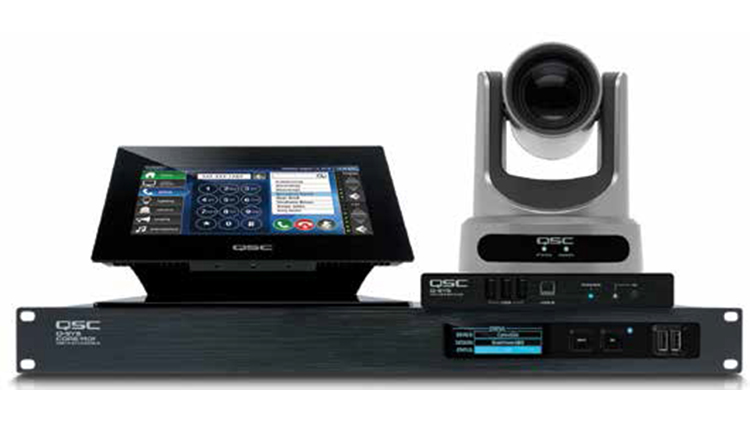
The latest edition of International Data Corporation’s (IDC) Worldwide Semiannual Public Cloud Services Spending Guide reports that Software-as-a-Service (SaaS) accounted for almost two-thirds of public cloud spending at the enterprise level in 2017—a number that will reach 60 percent by 2021. Companies in the United States, who promise to be the largest consumers of public cloud services, will invest $163 billion of the $266 billion in public cloud spending by 2021.

Frank Pellkofer, CEO, Utelogy
This is good news for people like Frank Pellkofer, CEO of Utelogy Corp. in Irvine, Calif. The company’s software-defined, cloud-based AV control platform will run on any network and server, including those that are virtualized. In other words, Pellkofer argues, Utelogy is a lot like many of the other systems tech managers are already running, and he underlines that virtualization plays a starring role in this. “[Virtualization] leverages the cloud, but it’s really the modern-day iteration of the old client-server model,” he said. “That, to me, is where the rubber meets the road. If it’s not virtualizable, then you’re not leveraging the real power of the cloud.”
Utelogy is one of several vendors offering software-based, centralized AV control. Among them are Atlona’s Velocity; Kramer Electronics’ Kramer Control; and QSC with its Q-SYS platform. “One of the most interesting trends that we’re seeing is the migration away from dedicated, purpose-built hardware control products and instead a movement toward true software applications that are tailored towards solving the same problem as we’re used to solving with hardware devices,” said Martin Barbour, product manager for installed systems at QSC.

Michael Crisci, Atlona
Michael Crisci, business development manager, AVoIP and strategic alliances at Atlona, headquartered in San Jose, Calif. attributes this to advances in consumer technology. He notes that ever since the launch of the first iPhone, people have been conditioned for a certain user experience—namely, an easy one. While AV control systems were often proprietary, requiring complex programming (usually by certified programmers), the shift toward drag-and-drop is finally making its way into this realm, streamlining the process for both tech managers and their users. “Really what we’re talking about is user experience,” he said. “User experience is the predominant theme—simplicity is what we as an industry need to focus on [so that people] can be as effective and efficient as possible.”
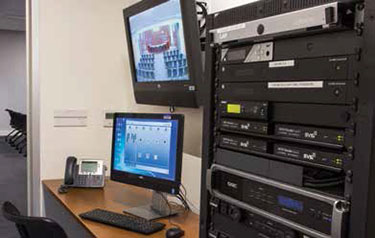
An example of Utelogy’s software-defined AV control used with SVSi and QSC.
A daily selection of features, industry news, and analysis for tech managers. Sign up below.
“Many of the consumer pieces of equipment that people buy, they will plug them in and it just works,” said Steve Greenblatt of Control Concepts, the AV programming and specialized software development firm. “That’s the expectation with regard to [enterprise] technology. And there is a disconnect: why is it that the AV industry is not providing an ‘it just works’ solution that is also tailored to [an enterprise’s needs]?” However, he adds, an out-of-the-box solution is usually not enough: “It’s taking that concept and then customizing it for a particular [organization].”
Programming a customized solution is one thing, configuring it is another. While a number of AV control technology developers offer configured solutions that enable tech managers to deploy systems with relative ease, Greenblatt argues that the functionality many organizations seek isn’t possible without added programming. At the same time, he acknowledges that tech managers often want the ability to make some changes on their own so that they don’t have to call in—and pay for—a programmer to perform small system tweaks. “What [tech managers] should be thinking about is working with somebody who is using programming but [who is also] giving them the ability to make their own adjustments and do some minor configuration,” he said.
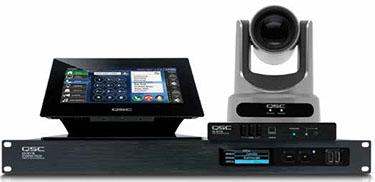
QSC’s software-based Q-SYS Platform is scalable and flexible.
With AV’s shift towards software-based systems comes the inevitable question: what’s the pricing model? As-a-Service subscription-based billing structures aren’t that prevalent in the AV industry right now, but chances are they will be. “I think as we start to see this migration to software-based control solutions leveraging off-the-shelf hardware rather than dedicated proprietary, purpose-built hardware, manufacturers need to look for a different method to recoup that investment,” Barbour said. For AV, the transition into a payment scheme that tech managers are already familiar with seems natural. “If you think about some of the campus-wide videoconferencing solutions that are both hardware and software-based, IT departments are already used to looking at licensing models for those. I think as we start to leverage standard computer technology to [run AV control,] it’s inevitable that we’re going to see licensing and software costs associated with that functionality.”
AI AND AV: ARE WE THERE YET?
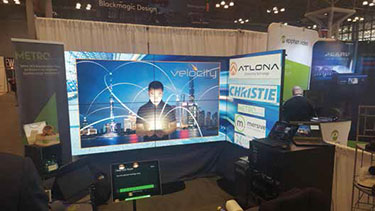
This demo shows a videowall control application with LED content from a Christie Spyder X80 through Atlona’s Velocity.
Not quite, but its potential for AV reaches beyond Alexa, or Siri, or voice commands. For Frank Pellkofer, CEO at Utelogy Corp., AI in the AV space will be most useful if it’s married with predictive analytics—and money. What would benefit organizations most is to have access to the data that helps them understand the effect their technology spends have on productivity, or student learning outcomes, he argues. What was a good investment? What isn’t paying off? Where do we need to focus our financial outlay to improve operations? “That’s all derivative results and decision-making driven by predictive analytics,” he said. “But that basically means that a system [has to be smart] and it learns from itself.”
IOT AND AV: ARE WE THERE YET?

Kramer Control solutions
Getting there, and it’s set to collide with AI. In some cases, it already has: last spring, Harman Professional Solutions and IBM Watson Internet of Things (IoT) announced their Voice-Enabled Cognitive Rooms that integrate Watson’s AI into a number of Harman products, including AKG microphones, JBL speakers, and AMX AV control. The systems enable users to issue voice commands for room set-up, and eventually, the technology will configure rooms automatically based on the data it has collected from users over time.
But taking full advantage of IoT requires AV/IT service providers to pay close attention to what tech managers are telling them. “The next level is taking what IoT provides and then making it into something that is valuable to [tech managers,]” said Steve Greenblatt of Control Concepts Inc. A room that recognizes meeting participants (including those calling in remotely), and therefore self-configures based on the data it has gleaned from IoT devices is one thing, “but that doesn’t necessarily apply to every culture and environment.”
To incorporate IoT effectively, Greenblatt says that AV programmers need to interview tech managers to discover how the organization actually operates. Are the users more hands-on when it comes to technology, or not? Are meeting spaces often used on an ad hoc basis, or is a strict scheduling policy in place? He uses one of his clients, a law firm, as an example: if a partner schedules a meeting, that room remains reserved for them whether they show up or not. Other companies have a no-show policy whereby that room is reassigned if nobody appears 15 minutes into the meeting’s pre-scheduled start time. “We have to understand what applies and what is going to be beneficial for each particular client and how we can use IoT to solve some of their needs and challenges, and make their day a lot easier, and make their workflow more streamlined,” he said.
THE AV BLOCKCHAIN: WE COULD GET THERE
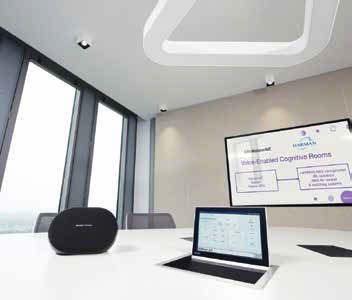
Harman’s voice-enabled Cognitive Rooms with IBM Watson
Many of us associate blockchain with cryptocurrency, but there’s an argument that one day, tech managers, AV manufacturers, and AV integrators will be able to apply it to their systems. “That’s where we can get really interesting with approaches to predictive analytics, predictive troubleshooting, and things like that,” Pellkofer said. “You can take trends [from] across the globe—customers that aren’t even my customers, but their data could be generically presented, and I can understand: in an AV environment for a university system, or an AV environment for an enterprise, if this device fails at this layer, then you have a 70 percent chance of 17 per 100 rooms going down. That kind of information will save organizations huge, relative to their total cost of ownership.”
Carolyn Heinze is a freelance writer/editor. She regularly contributes to AV Technology magazine.
Carolyn Heinze has covered everything from AV/IT and business to cowboys and cowgirls ... and the horses they love. She was the Paris contributing editor for the pan-European site Running in Heels, providing news and views on fashion, culture, and the arts for her column, “France in Your Pants.” She has also contributed critiques of foreign cinema and French politics for the politico-literary site, The New Vulgate.
